Learn step by step how to make a smoked ribeye roast on ANY grill or smoker!
Whether you've got a Traeger or Pit Boss pellet grill, a Masterbuilt electric smoker, or even just an old Weber kettle, we've got step by step instructions for you.
Take your prime rib to the next level with this smoked rib roast that is sure to impress even the most discerning guests!

A ribeye roast, sometimes called a boneless prime rib or boneless rib roast. In fact, a ribeye roast is just a prime rib with the rib bones removed.
The boneless ribeye roast is what ribeye steaks are cut from.
Today, we are smoking a ribeye roast whole and then slicing and serving it like a delicious prime rib.
We are going to cover:
- How to prep your ribeye roast for the smoker
- How to set up different grills and smokers for a smoked ribeye roast
- What temperature to smoke your rib roast
- The best wood choices for a smoked ribeye roast
- How to know precisely when your smoked prime rib roast is finished
- How to rest, slice, and serve your perfect smoked ribeye roast.
Wow, that's a lot...so let's jump in!
Jump to:
How Big of a Roast Should I Buy?
Some ribeye roasts come with the bones removed, but then tied back on by the butcher for presentation and to hold them against the meat while cooking. Other ribeye roasts are sold boneless.
You will see some ribeye roasts with 3-4 bones and others with as many as 6. Usually the roast will be about 2 lbs per bone.
So an 8 lb ribeye roast will have 4 bones.
A general rule of thumb is to cook 1 lb of meat per person so a 6 lb ribeye roast would serve about 6 people .
Video
Rather WATCH than read? Check out our video on our YouTube Channel:

Prepare the Roast
Thankfully you won't need to do much of anything to your ribeye roast other than season it before you smoke it.
Don't remove the strings before cooking!
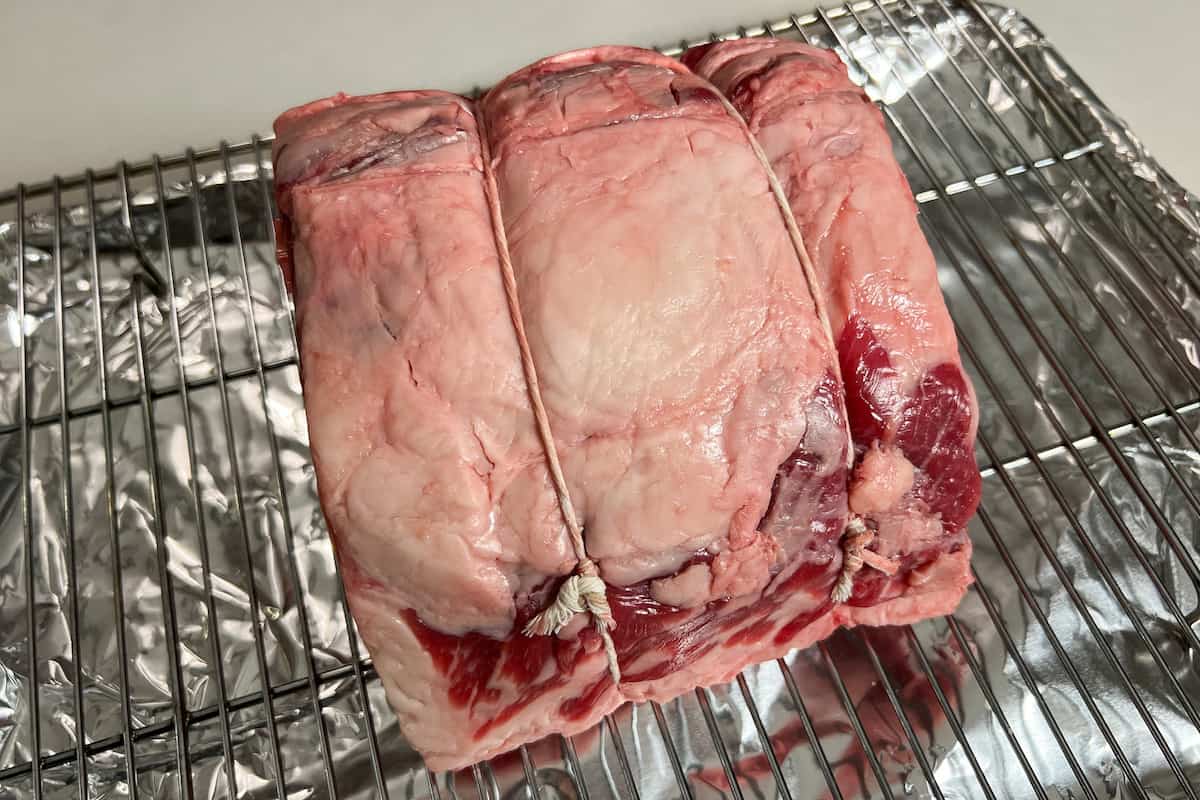
If you are cooking s bone-in ribeye roast, these strings are holding the bones in place and you want to keep everything held together while it is cooking.
If your ribeye roast is boneless, the trings will help the roast hold its shape while smoking.
Season the Roast
When it comes to an expensive, top of the line cut of meat like a prime rib, or ribeye roast, you want to keep the seasonings simple and let the meat shine through.
Save the flashy sugary and spicy BBQ rubs for your brisket, ribs and pork butts.
For our recipe below, we simply use kosher salt and black pepper on our smoked ribeye roast, and then brush on a garlic and herb butter while it smokes.
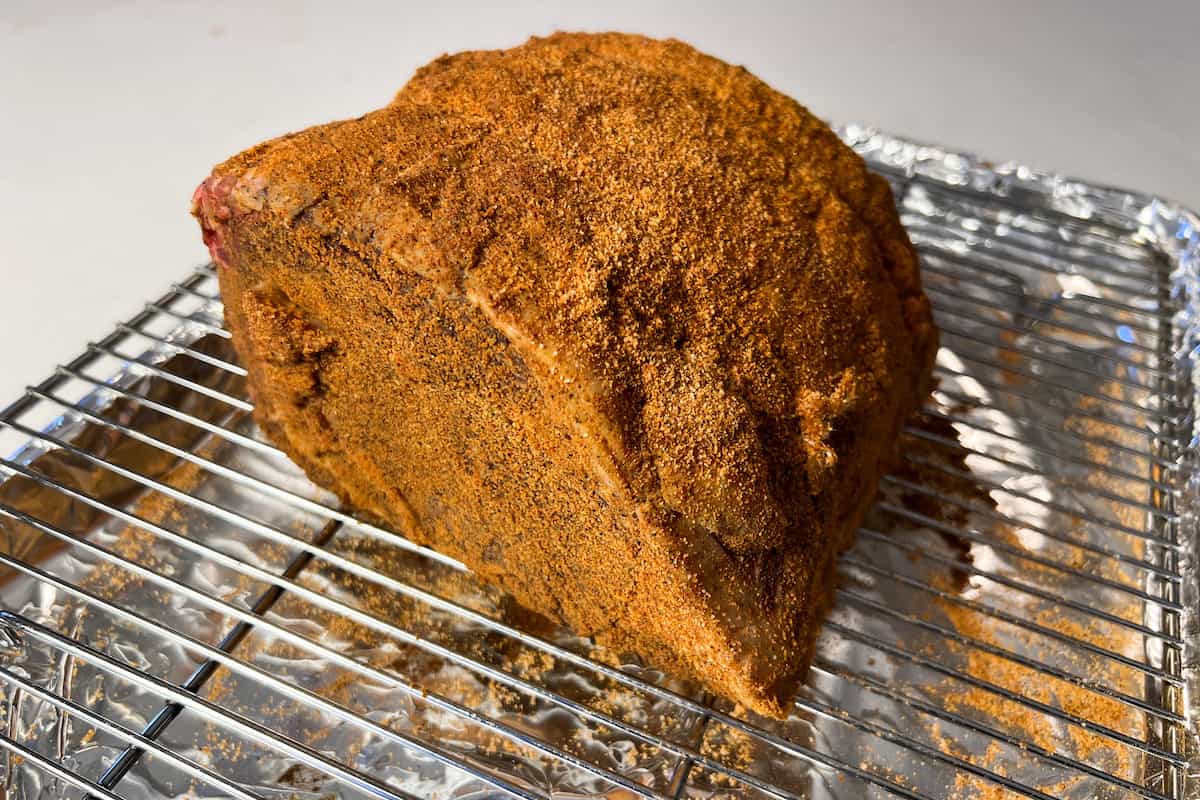
You should also avoid any BBQ and Spice rubs with a heavy amount of sugar in them if you plan to use high heat searing or else the sugar will burn.
We like Bad Byron's Butt Rub because it has a lot of flavor and contains NO SUGAR.
We coat and marinate the ribeye roast for at least 2 hours, preferably overnight, wrapped in plastic wrap in the refrigerator before placing on the smoker.
This gives the salt plenty of time to work its way into the meat and really flavor it all the way through.
Wood Choices
For a big robust piece of beef like a smoked ribeye roast, go with something like hickory or pecan that will compliment the beef well.
If you want to keep it simple and straightforward, choose a lighter smoking wood like oak, apple, or peach, although these lighter fruitwoods may not impart as much smoky flavor into the beef as they might with chicken or fish.
When in doubt, you can always mix and match your choices.
Cooking Temperature
We recommend setting up the smoker to cook at 250°F.
This seems to be the sweet spot where its low enough that the outside doesn't overcook but also high enough that the roast doesn't cook so long that it dries out.
You HAVE to use a good instant read meat thermometer to know where the internal temperature is of your smoked ribeye roast.
Ideally you want a good leave in probe thermometer like the ThermoPro as well as a second instant read to spot check different depths and areas on the roast.
- 300ft remote range
- Oven safe with highly accurate stainless steel meat probe and oven/ grill/ smoker temperature probe, to allow you to monitor both food and ambient temperature simultaneously
- Food temp & HI/LOW ambient temp alarm
- Highly accurate temp range 14˚f to 572˚F; Displays both Fahrenheit and Celsius
While we have used and recommended ThermoPro for years, lately we have also become big fans of the MEATER leave in thermometer.
It is extremely accurate and has an incredible 165 foot Bluetooth range and works right with your smartphone so you don't need to carry a separate controller around with you like many other remote thermometers require.
It's got a great free app that is constantly being updated and even has an algorithm to predict how much longer your type of meat will take to cook based on cooking temperature, target temperature, and current internal temperature.
It's like a GPS for your meat!
- Dual temperature sensors enable you to monitor both the internal meat temperature (up to 212°F) and the ambient/external temperature (up to 527°F) at the same time.
- Dishwasher safe
We are going to slowly bring the internal temperature up to about 115°F, then crank the heat as hot as we can to reverse sear the ribeye roast until the internal temperature hits about 125°F and then remove it from the smoker.
The roast should continue rising as it rests up to a perfect medium rare: 130-135°F.
You can't do all this without accurate thermometers. There is very little room for error when smoking a ribeye roast.
We are particular fans of this one from ThermoPro because of its durability and affordable price.
Everyone from beginner smokers to competition cooks can benefit from using an instant thermometers to consistently make great food.
Cooking Time
Most rib roasts, no matter the size, will take about 3 hours to smoke up to 115°F at 250°F
This is because no matter the weight of the ribeye roast, they are all roughly the same thickness, which has the largest bearing on cooking time.
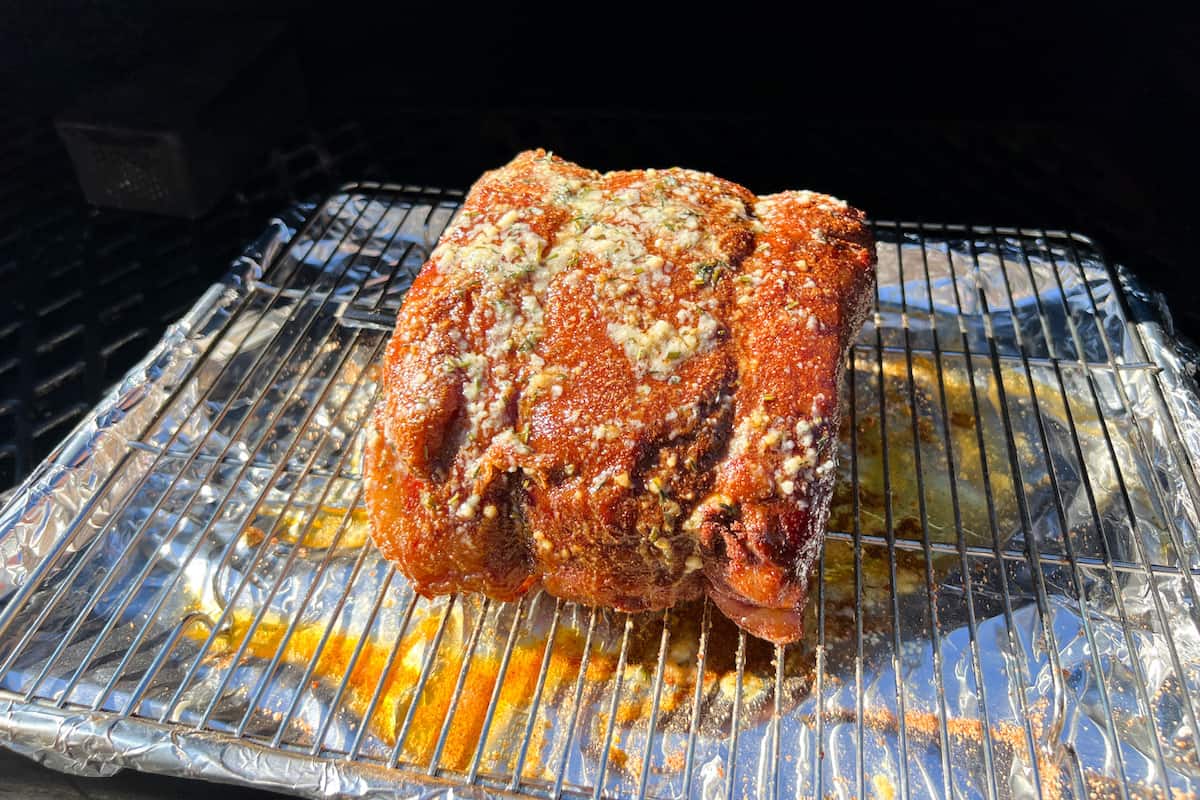
The once we sear at 500°F, it will take about another 15-20 minutes to reach 125°F internally.
Finally, you will need to let the meat rest for about 30 minutes after cooking it before carving.
Unless you want all those delicious juices running all over your cutting board instead of staying in the meat where you want them, you need to set aside time for the meat to rest, and a large piece of beef like this needs extra time.
Reverse Searing
"Reverse Searing" is just a fancy term for searing your meat at the very end, once it is pretty much all the way cooked through, in order to get a nice crispy exterior crust that you sometimes just can't get from low and slow smoking alone.
In this case, we are not technically going to sear the ribeye roast like we might do with a steak in a pan like we did with our smoked ribeye steak recipe.
Rather, we are going to bring the temperature of our smoker or grill up as high as it will go right at the very end of cooking, and only for a few minutes, in order to get a nice, golden brown crust on the outside of our smoked ribeye roast without overcooking the inside.
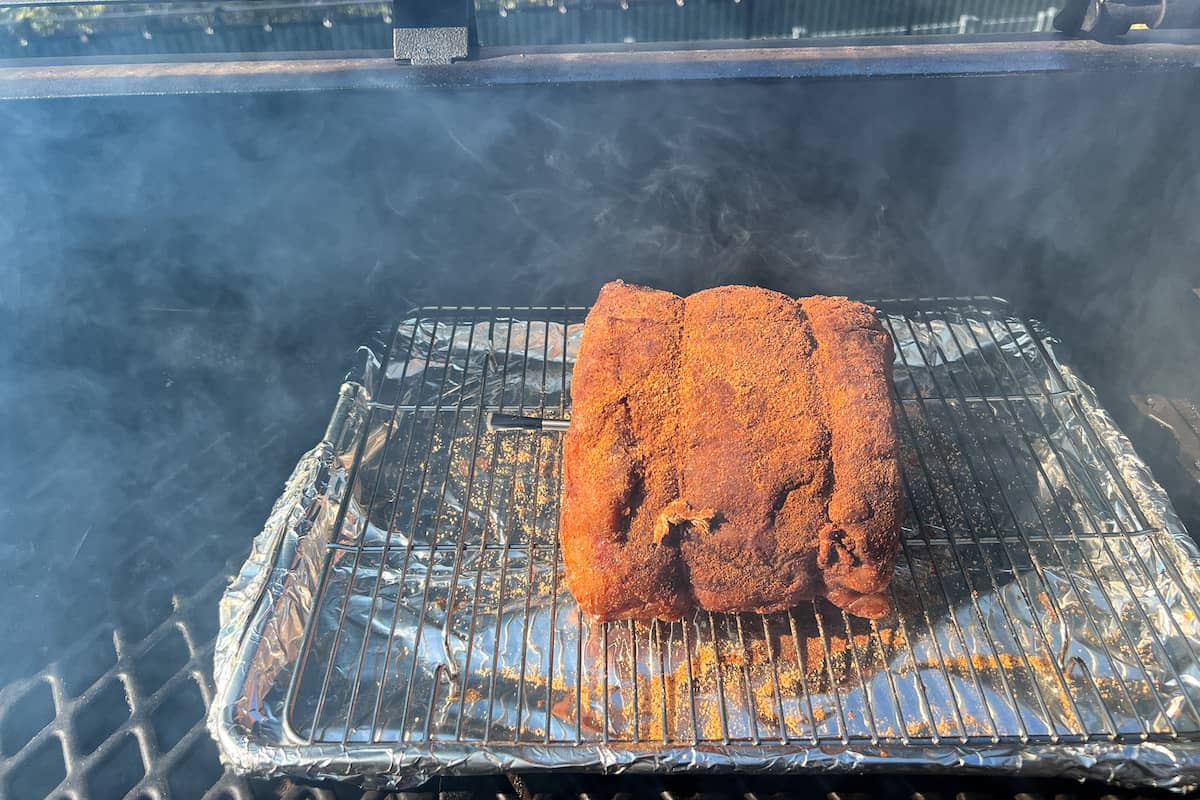
This step isn't 100% necessary.
You can just as easily leave it on the smoker at 250°F until it goes all the way up to 125°F internally, we just think you'll like the contrast of textures you get from a crispy crust and a fall apart tender interior.
And it isn't that hard to do, so keep reading!
If you wish to reverse sear the meat, you will want to smoke it at 250°F only until it reaches an internal temperature of about 115°F. At this point it will still be very rare.
Next, you will either open up all the vents, turn up the burners or temperature settings, or move it to an indoor oven preheated to 500°F.
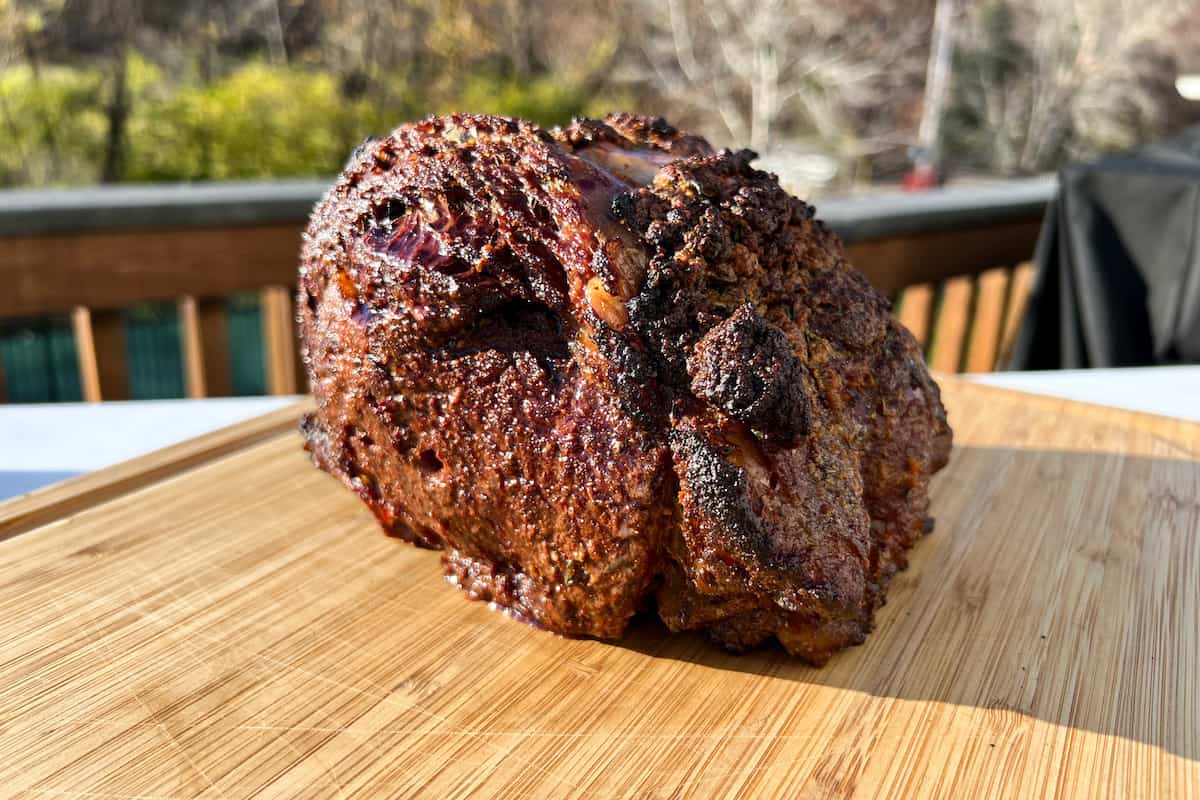
You need to watch your smoked ribeye roast VERY closely at this point as it may only need maybe 10-15 minutes total at this temperature.
Watch for the exterior fat to begin to sizzle and crisp up, watch for the color to turn from grayish to medium-dark brown, and whatever you do, do no leave it unattended to burn or over cook!
Use your meat thermometer to make sure the internal temperature has reached 122-125°F and no further.
Carve and Serve
You will then remove the smoked ribeye roast from the hot smoker, grill, or oven and let it rest.
You can tent loosely with foil but DO NOT wrap it tightly or it will overcook from its own residual heat.
Let the smoked ribeye roast rest for about 30 minutes before carving.
Once the smoked ribeye roast has rested you will want to cut the ties an remove them from the roast.
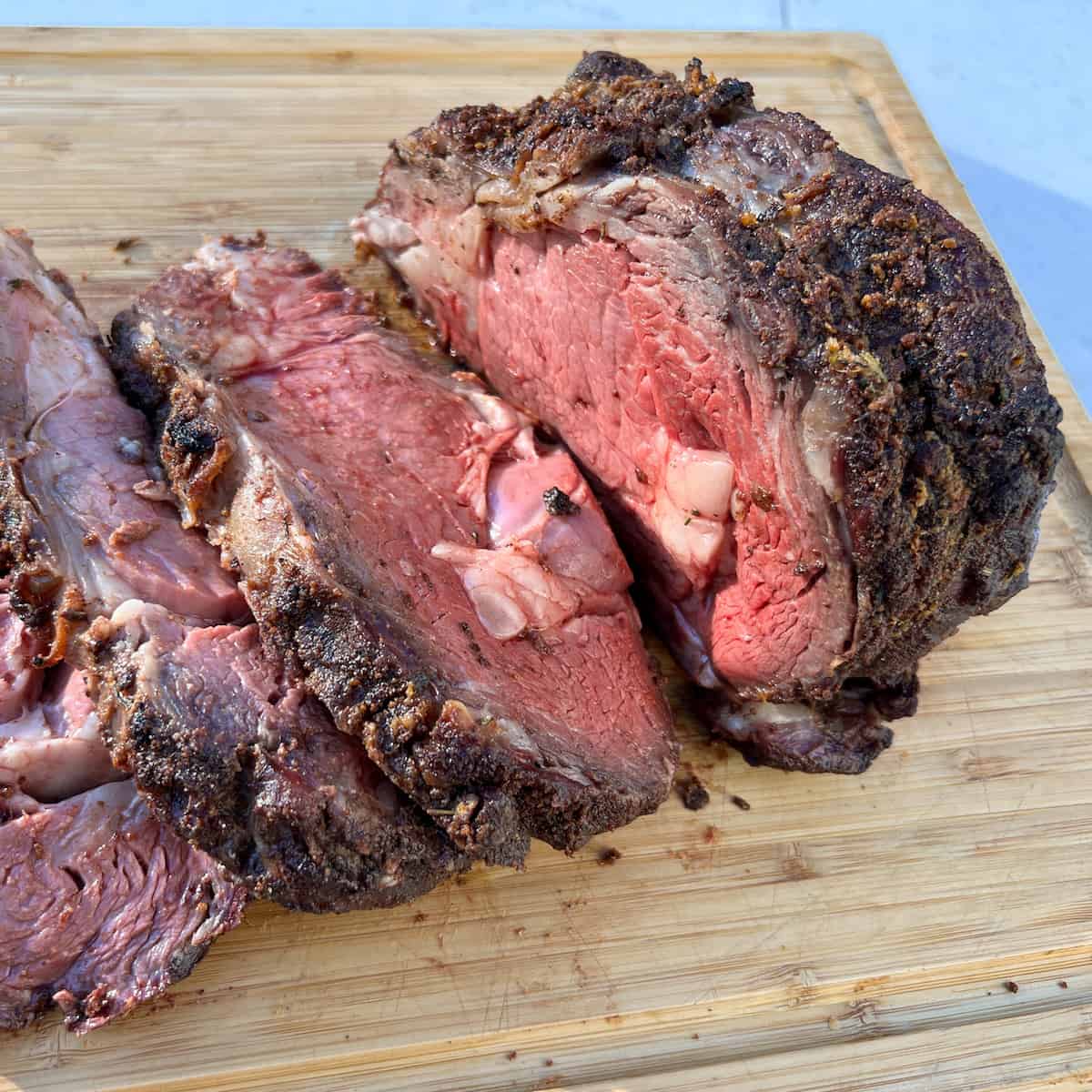
Place the rest of the roast on the cutting board.
Use a good meat slicing knife and cut the smoked ribeye roast into nice thick slices based on how many guests you are serving.
We particularly like this meat slicing knife from Mairico.
- IMPECCABLE PERFORMANCE: The long, ultra sharp blade is engineered to deliver highly precise cuts with minimal effort.
- PROFESSIONAL DESIGN, SUPERB QUALITY: Most desirable length by professionals. Sharp blade with premium stainless steel engineered to excel on all cuts of meats, including big roasts. It is also designed to last.
The outside slices will be more done than the very center if you have guests who prefer various levels of doneness.
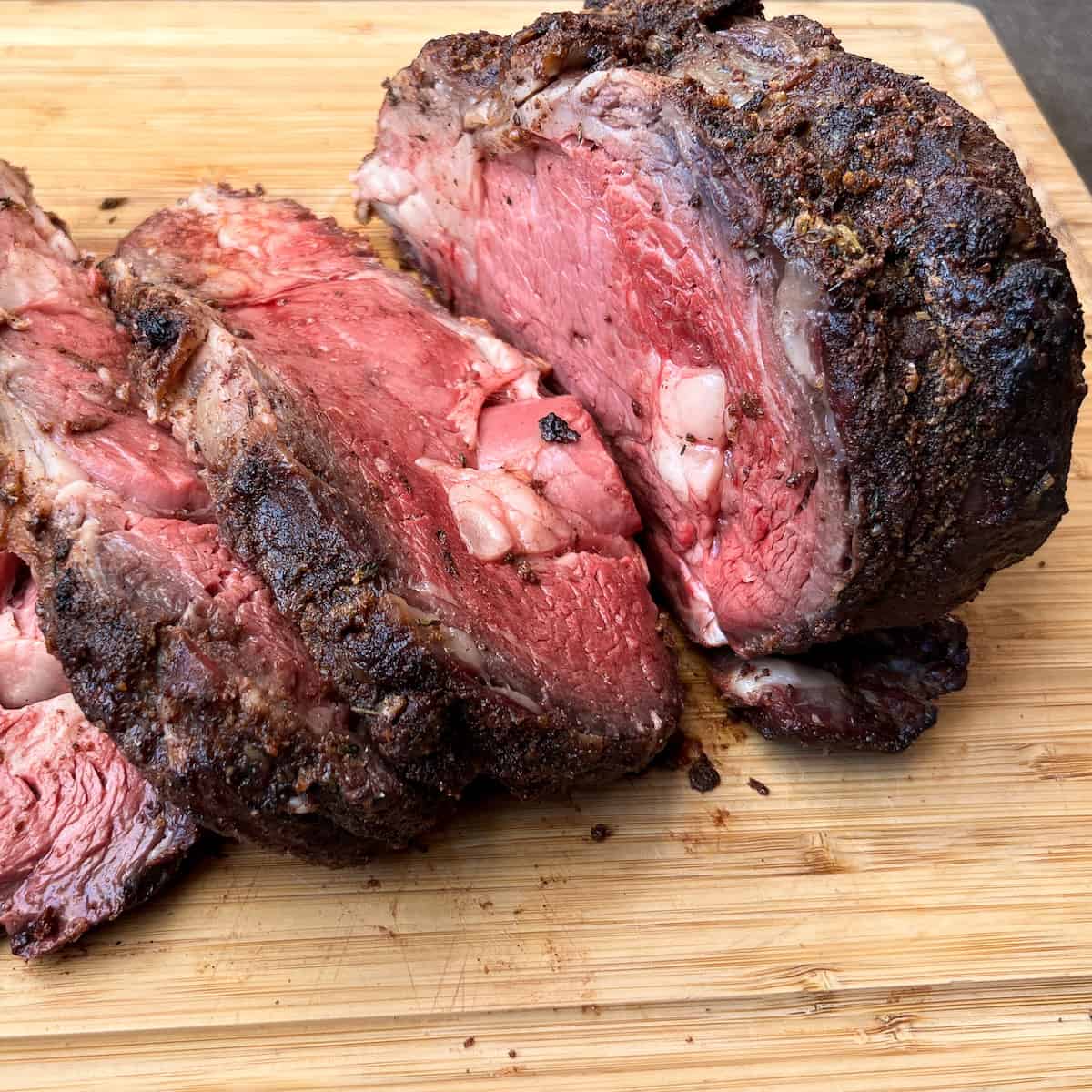
What to Serve on the Side
You also can't go wrong with a flavorful jus or horseradish cream to cut through the richness of the smoked ribeye roast.
On the side you can serve roasted asparagus or Brussel sprouts. You can even cook them on the smoker alongside the roast if you wish.
Smoked Mashed Potatoes and a glass of spicy Australian Malbec will pair nicely against the garlic and beef.
📖 Recipe
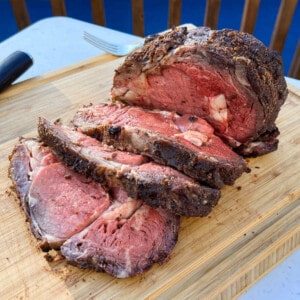
Smoked Ribeye Roast with a Garlic Herb Butter
Equipment
- Smoker or Grill
- Cutting Board
- Meat Slicing Knife
- Aluminum foil pan
- Instant Read Thermometer
- Probe Thermometer
- Wood for smoking (chunks, chips, or pellets). Preferably Hickory or Pecan.
Ingredients
- 1 4-6 lb Ribeye Roast, boneless plan on 1 lb per person served
- 2 tablespoon Worcestershire Sauce
- 3 tablespoon Kosher Salt
- 2 teaspoon Fresh Black Pepper
Garlic Herb Butter Marinade
- 1 stick Unsalted Butter High smoke point like avocado or grapeseed oil
- 1 tablespoon Fresh minced garlic about 3 cloves
- 1 teaspoon Fresh Chopped Rosemary
- 1 teaspoon Fresh Chopped Thyme
Red Wine Au Jus
- 2 cups Beef Broth
- 1 cup Red Wine
- 2 tablespoon Salted Butter
- 1 sprig Fresh Rosemary
- 1 pinch Fresh Black Pepper
- 1 pinch Rubbed Sage
Instructions
Prepare the Ribeye Roast
- Take the ribeye roast out of the packaging but DO NOT cut and remove any strings. Place on a wire rack over a baking sheet wrapped in aluminum foil1 4-6 lb Ribeye Roast, boneless
- Rub with a thin layer of Worcestershire sauce.2 tablespoon Worcestershire Sauce
- Sprinkle the outside with the kosher salt and pepper. Add more depending on the size of the Roast3 tablespoon Kosher Salt, 2 teaspoon Fresh Black Pepper
- Wrap in plastic wrap and place in the refrigerator until ready to put on the smoker. Preferably overnight.
Set up the Smoker
- Start or light your smoker and bring the temperature up to 250°F. If using a gas or charcoal grill, only light one side and set the grill up for indirect heat.
- Add wood to the smoker using either chunks, a smoker box, or pellet tube smoker.
Smoke the Ribeye Roast
- Place the ribeye roast, still on the wire rack over the baking sheet, in the cooking chamber away from any direct heat. Place a temperature probe into the deepest part of the rib roast.
- Cook until the internal temperature reaches about 110-115°F, which will be about 3 hours.
Garlic Herb Butter Marinade
- While the roast is smoking, mix together the Garlic Herb Butter Marinade ingredients in a saucepan over medium-low heat.1 stick Unsalted Butter, 1 tablespoon Fresh minced garlic, 1 teaspoon Fresh Chopped Rosemary, 1 teaspoon Fresh Chopped Thyme
- Stir until the butter has melted and simmer gently on LOW for 15-20 minutes.
- After an hour of smoking, baste the garlic herb butter on the ribeye roast using a silicone basting brush. Continue smoking the roast basting about every 30 minutes.
Red Wine Au Jus
- During this time you can also make the optional Red Wine Au Jus.
- Combine all the Au Jus ingredients in a saucepan and bring to a boil stirring occasionally.2 cups Beef Broth, 1 cup Red Wine, 2 tablespoon Salted Butter, 1 sprig Fresh Rosemary, 1 pinch Fresh Black Pepper, 1 pinch Rubbed Sage
- Turn the heat down to MEDIUM LOW and simmer for about 20-30 minutes.
- Strain and set aside before serving.
Sear the Ribeye Roast
- Once the ribeye roast has reached 110-115°F internally, turn up the heat or open all the vents to reverse sear the roast, ideally at around 500°F. You can also transfer the wire rack to an oven set to 500°F if you are not able to achieve this temperature on your smoker.
- For medium-rare, cook until the internal temperature rises to 122-125°F then remove from the smoker, oven or grill.
Rest, Slice and Serve
- Let the smoked ribeye roast rest on the wire rack or a cutting board, loosely covered in foil, for about 30 minutes. The internal temperature should continue to rise up to 130-135°F.
- Add the drippings from the pan to the Au Jus. Use a fat separator if desired.
- Cut the ties off the rib roast.
- Place the roast on a cutting board and slice into ¾" slices for each guest. Serve with the warmed and strained Au Jus.






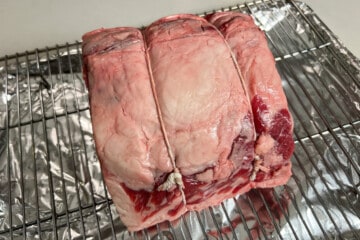
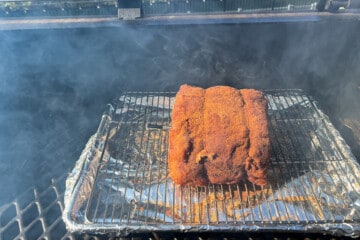
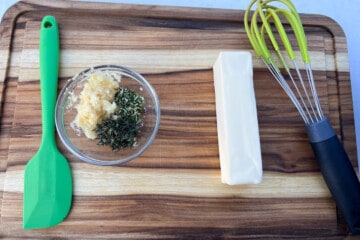

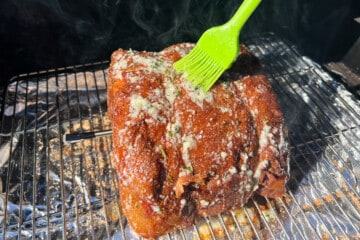
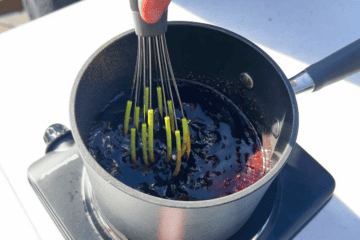
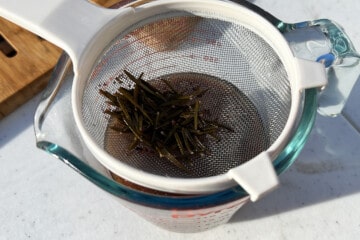
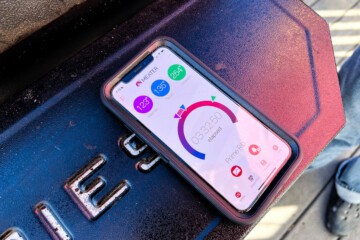
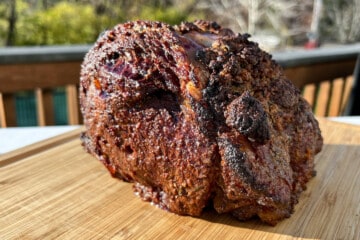
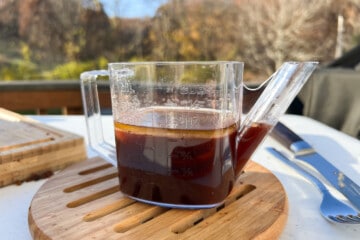
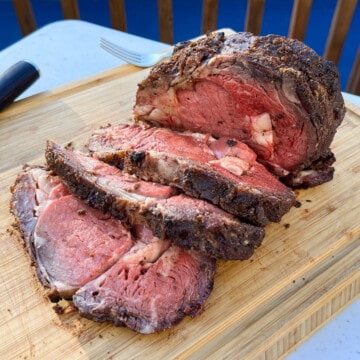
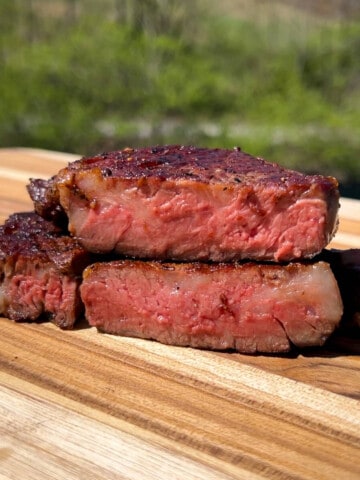
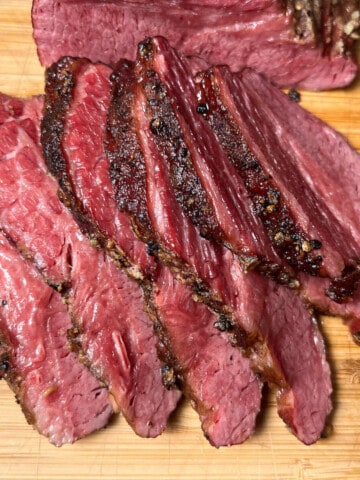
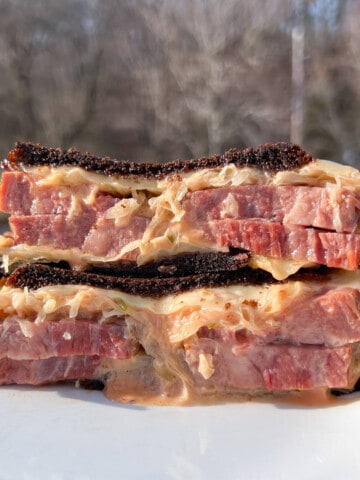
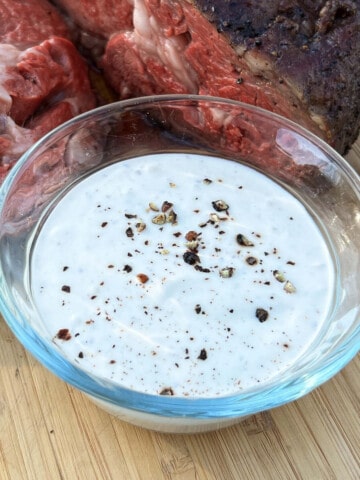
Jim P. says
Did this last night on out Traeger. Came out really well but next time I would have pulled it off a little sooner, maybe closer to 120 or 125, but thanks for sharing!
Mad Backyard says
Thanks, Jim. You are right you can always pull it off a little earlier if you like it more on the rare side. You can always put it back on if needed but can't put that genie back in the bottle if you over do it!
Sheila says
This came out great on Easter, nd looked beautiful. Thanks for the tip about leaving the bones attached while it cooks!
Mads Martigan says
Glad to hear it Sheila!
Frank Dunks says
Thank you for the superb directions on rib eye roast smoking. I have a Yoder smoker grill, and we agreed that our Christmas dinner was the best we have ever had. Thanks again for the help.
Mads Martigan says
That's great Frank! Glad the ribeye roast came out well and thanks for the feedback. We are actually getting ready to do a whole series about Yoder smokers so stay tuned!